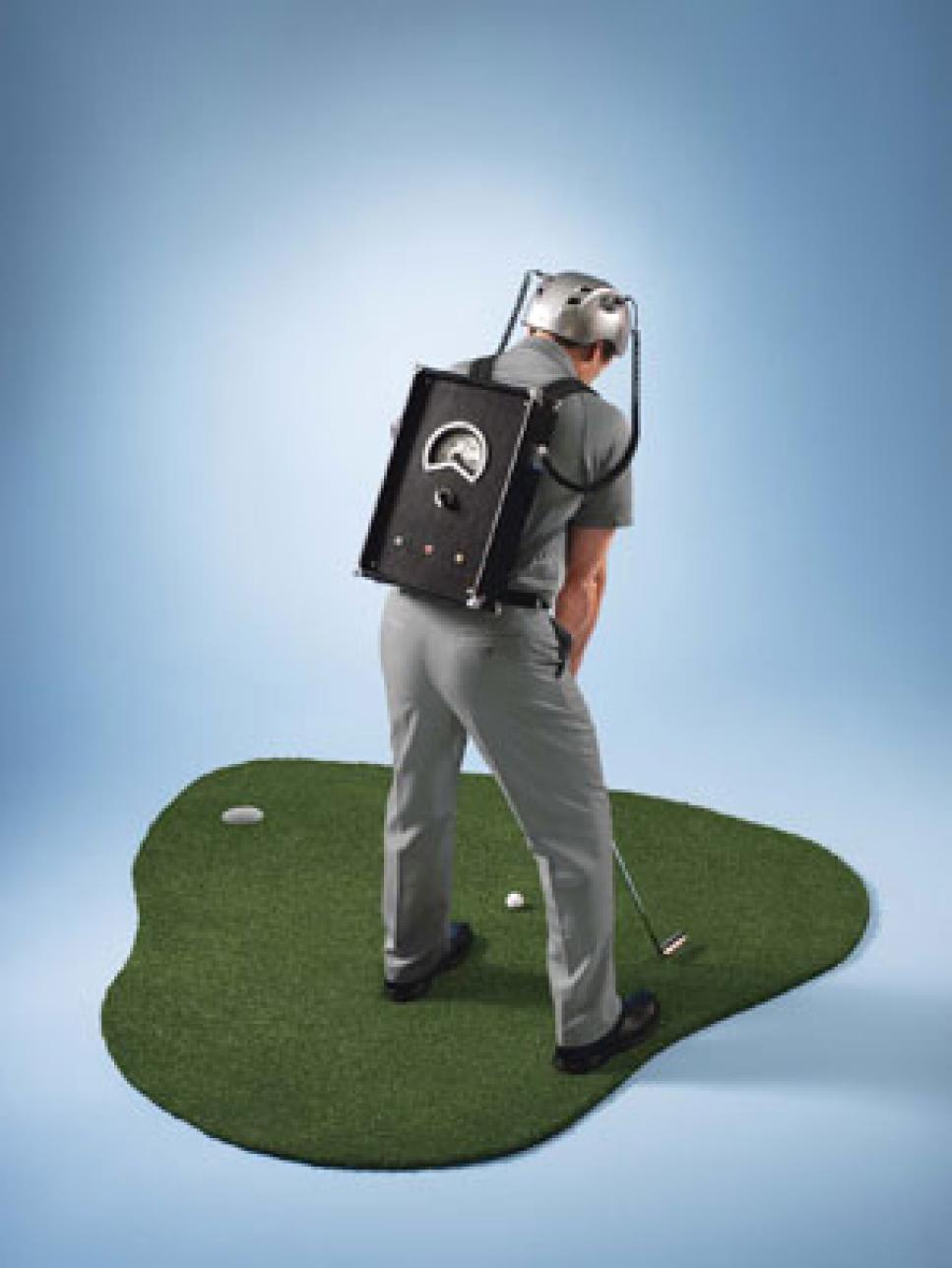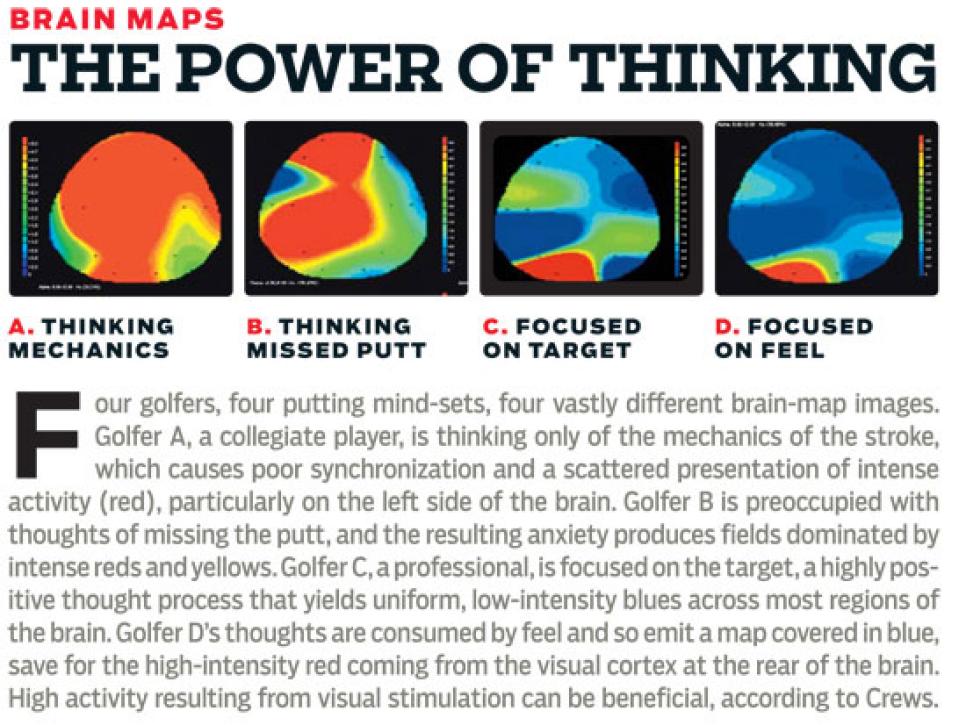Short Game
How To Train Your Brain

It's a sun-drenched morning at the ASU Karsten Golf Course, and psychology consultant Debbie Crews, Ph.D., a faculty research associate at Arizona State and chair of the World Scientific Congress of Golf, is describing the brain activity of a typical golfer in the midst of a wretched putting performance. She explains in harrowing detail the anxiety, the increased heart rate, the helpless feeling of being misaligned, the complete absence of feel, the sensation of knowing the important three-footer for par has no chance of touching the hole, and finally, the pathetic stroke that results. Crews paints a dark picture, and the Arizona sun, as if on cue, momentarily slides behind the only cloud in the sky.
"Maybe I shouldn't describe this out loud," laughs Crews, who has pursued answers to the psychological riddles of putting for 25 years, including a 1997 study showing the ruinous effects on the putting of golfers who have TV cameras trained on them. "Let me show you." She pulls from a bulging folder a series of images that appear similar to MRI scans and points to the variation in color from one image to the next. "This is the amateur, and this is the professional," she says, pointing to separate brain scans. "Notice the difference?"
There is a difference, the convoluted, angry reds and pale yellows of the amateur's brain images contrasting sharply with the symmetrical, cool blues and pleasing greens of those of the professional. The colors, Crews explains, are measures of vibration, or electrical frequencies picked up by EEG sensors placed atop 12 locations on the player's head, six on each hemisphere. Each location represents a different facet of thought, emotion or physical activity, with the left side of the brain controlling logical, analytical thinking, and the right side in charge of the more creative, intuitive components. Crews imposes a wide range of thoughts or moods on her subjects, from the positive -- "think target," "breathe," "feel" -- to the downright disruptive, distracting them with sounds and even asking them to "think miss" when making the stroke. The result is a striking variety of brain-map images that are different not only in color but in how the colors are dispersed. Positive, organized thoughts are expressed as patterns that are fairly symmetrical. Scattered thinking and feelings of fear or agitation come out more like a Rorschach inkblot test or a child's finger painting, the colors and shapes erratic and jumbled.
Her goal is to one day help all golfers produce a uniform image profile on command -- and reap the benefits in improved putting. It'll be no mean feat, as she still is streamlining the process of gathering and analyzing data. The results she has so far are impressive, considering each image requires six separate software systems to operate on six computers simultaneously, producing 267 individual measurements in the three-second time frame of a putt. The data is then integrated into a single tell-all image. Crews, with the help of ASU professor and software designer Kanav Kahol, Ph.D., and electrical engineer Bob Apparian, is helping golfers control the individual brain environments through changes in attitude, focus and routine. The idea, Crews says, is to synchronize the measures so the colors in the images are predominantly of one type and flow together smoothly. This allows golfers to putt with a blend of confidence and concentration.
Crews loathes the term "zone" (she prefers "synchronicity"), but in the end she is striving to create the ideal performance state and make superb putting a simple, almost reflexive action. She believes strongly in attitudes that evoke a metaphysical quality, sensations like "willing the ball into the hole." She offers as proof examples of extraordinary putting performances on bumpy surfaces, most recently Graeme McDowell mastering the inconsistent greens at Pebble Beach to win the U.S. Open. It's one of many cases of a well-integrated mind overcoming physical barriers. Crews overflows with optimism for what it can mean to golf instruction, as she has seen high-handicappers with poor technique excel despite their lousy mechanics. To her, it's proof that an effective state of mind is as important as sound technique.
One of her favorite case studies of mind over matter involves actor Alan Alda of "MAS*H" fame, who as host of the PBS series "Scientific American Frontiers" did a segment on Crews' putting research in 2002. Alda was not a golfer and performed poorly when asked to hit a series of 12-foot putts while wired with sensors. Crews attributes his inconsistency to his being utterly unsure of himself as he grappled awkwardly with the putter, a feeling all novices are familiar with. Crews then had Alda stand on a balance board, followed by a short but intense workout on an exercise bike. When Alda's heart rate increased, it triggered greater activity in the right (creative) side of his brain so that it better coincided with the left (analytical) side. Still out of breath, Alda returned to the putting station and proceeded to drain six of 20 putts -- better than some professionals she'd tested. An even more impressive feat followed, when Alda defeated former LPGA Tour player Tina Tombs in an impromptu head-to-head putting match, Tombs weighted down by the pressure of knowing she should win, and Alda blithely concentrating only on breathing and feel.
Crews' research study has progressed in the last eight years to include additional measures of a player's hands, feet, the ball and the putter itself, using a device known as an accelerometer. Revelations about performance have emerged, including the fact that a player feeling nervous -- registered as bright red on the images -- is a good thing. "There isn't a good player coming up the 18th hole with a one-stroke lead who doesn't feel high stress," Crews says. "What's important is that the elevated state of arousal be in balance with other areas. If some of the images show red, we don't want it changing abruptly to blue or green. We like to see the high arousal in all areas." Crews points out that a quiet, meditative state can be as beneficial as nervousness, but calm is more difficult to attain because it's not a natural reaction to stress.
Some of the advice Crews offers the average player with no access to her technology can be daunting. For instance, she says that when you're confronted by the fight-or-flight response all humans experience under pressure, you need to train yourself to embrace the challenge rather than fear it. "Learn to like the butterflies," she says, which for many golfers is easier said than done. But much of what she has learned from her research is practical and borne out by the images. "The player who involves the mechanical side of the brain too much, like Alan Alda did when putting for the first time, is in trouble," she says. "You should pay a great deal of attention to aim, alignment and factors like that at the beginning, and then shut down the mechanical side of your brain. At that point you want to be target-oriented and allow your imagery, feel and emotion to take over."
Crews advises golfers to invite emotion into the putting process. "Emotion gives you intensity," she says. "When you hear about golfers willing the ball into the hole, they don't do that by being in an unemotional, flat-line state of mind." Also crucial, Crews says, is making an effort to complete the putt-ing stroke. "A complete follow-through shows you performed the stroke with authority and clear intent. A weak finish means a weak putt."
Asked if one overarching lesson has come out of her research, Crews pauses and nods in the affirmative. "I'd say it's not what you think that matters, but how you think. And if you think the right way, all things are possible."
Not surprisingly, the sun emerges from that lone cloud in the sky.
